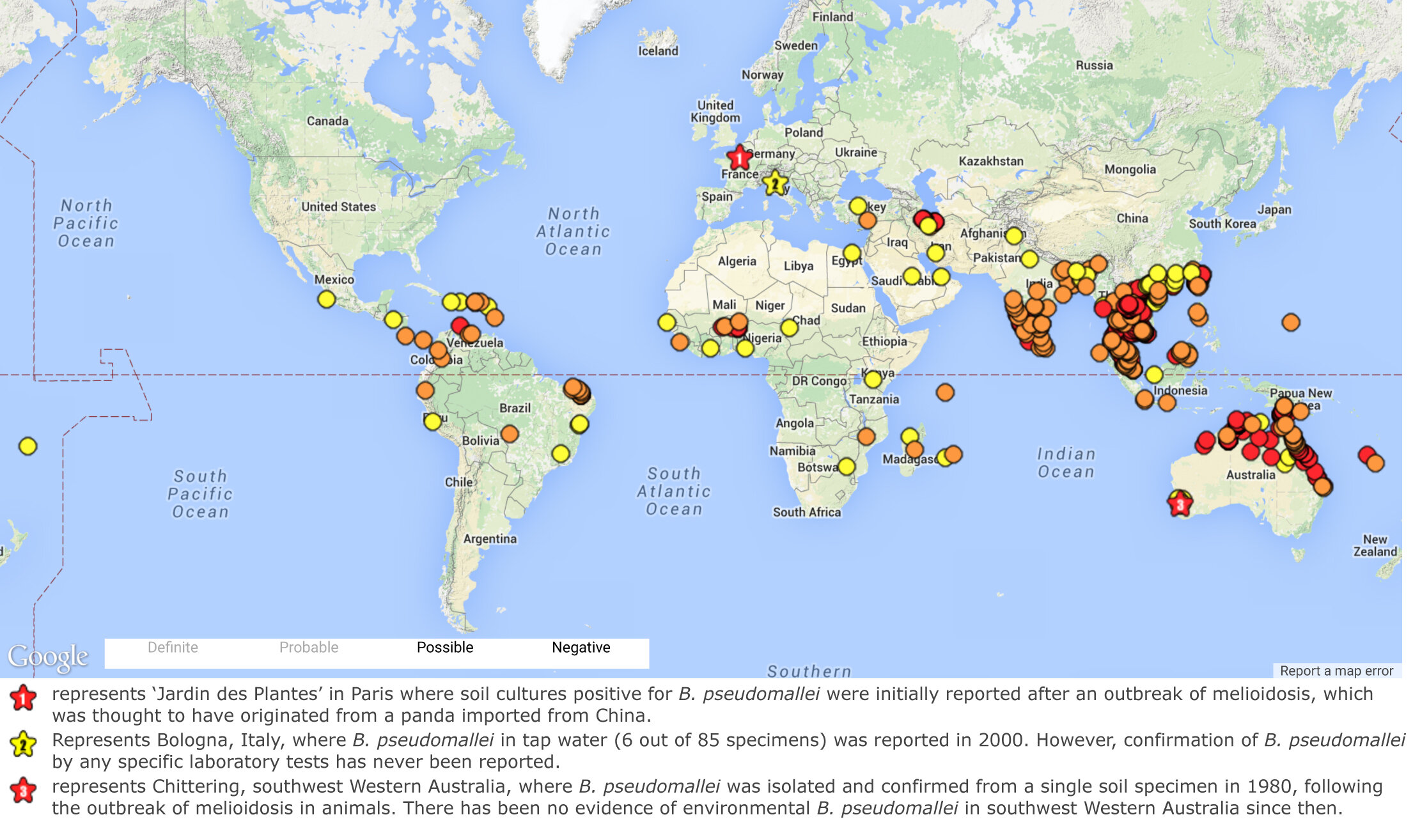An Obligatory Melioidosis Write-Up

A disease called melioidosis is getting a lot of media attention, which means it's an ideal time to provide some clues to how it might appear in a game.
I regularly follow seven or eight different news sites and, at one point, every one of them has had a feature about melioidosis, a bacterial disease which has never really achieved much media attention despite being putatively responsible for something in the area of one hundred thousand deaths per year worldwide according some sources. Since the disease is getting so much attention at this brief moment in time, it seemed like an ideal time give a brief write-up and provide some clues to how it might appear in a game.
The bacteria Burkholderia pseudomallei causes two diseases, one of which has important implications for human health and one which doesn’t so much. The less important disease is known as glanders; it primarily affects horses and donkeys but, in any event, hasn’t been reported in most of the world for between 60 and 100 years, remaining a common problem in some parts of Africa and Asia. Infected animals develop a host of lung problems and, if humans come in direct contact with an animal’s secretions the human can be infected and develop much the same symptoms.
The other disease caused by Burkholderia pseudomallei is the momentarily-famous melioidosis. Mostly common in tropical climates, a handful of cases are reported each year in the United States and we don’t know how many cases are missed because a patient’s symptoms are instead identified as another infection. The bacteria thrive in soil and water, and infect humans by ingestion or by entering the body through wounds. Humans are mostly at risk if they have another condition weakening their immune system, which previously wasn’t terribly scary but which we’re understanding more and more includes such conditions as diabetes and older age, both of which are increasingly common. One of the concerns about melioidosis is that it can cause a host of different symptoms, which means it’s easily mistaken for another illness. In medieval fantasy, of course, where every disease is treated more or less the same way, this doesn’t matter very much, but in the real world it means people receiving potentially the wrong medications.
If bacteria enter the body through a wound, melioidosis manifests as a local infection. One to five days after infection, the area around the wound becomes swollen and painful. This usually lasts a few days and then improves. If the infection isn’t fought off, then within 7-10 days of infection, it can spread to the blood and the rest of the body, causing general organ dysfunction, drop in blood pressure, liver and kidney damage, pus-filled skin eruptions, and in 90% of cases, death within 1-2 days of worsening of symptoms. In game terms, this likely means a relatively difficult initial Fortitude save at the time of infection, followed by an easier second Fortitude save at 1d6 days, with failure of the second save leading to rapid extreme Constitution damage.
If the disease enters the respiratory tract, it can infect the lungs over the course of two weeks, triggering increased mucus production which can impair breathing and effectively cause someone to drown in their own fluids. Assuming the person survives the ensuing pneumonia, skin lesions and other systemic manifestations of melioidosis can begin to appear months later, tending to be more mild but still impairing.
What makes melioidosis useful to a storyteller is its flexibility. Characters might contract melioidosis in a host of ways: blood-spatter from an orc, spittle from a dragon, or even from breathing in a cloud of dust kicked up from the floor of a tunnel. Most characters exposed to melioidosis will develop fairly mild symptoms which might manifest as pretty much any effect which a storyteller wants: subdual damage, hit point damage, or damage to any ability score most convenient to the story. Player characters, with their high ability scores and ready access to healing magic, are unlikely to be at meaningful risk of the really dangerous effects of melioidosis, but a contagion spell can change that quickly. Melioidosis is also noteworthy for being relatively easy to weaponize in the real world, and even in a medieval setting, an evil alchemist or spellcaster might easily stumble across the idea of aerosolizing infected dirt or bodily fluids to infect either specific targets or large numbers of people. Characters without access to healing magic may be quite a lot of trouble; few to no folk remedies seem to exist for melioidosis and, without either magic or powerful purified antibiotics the likes of which don’t exist in most fantasy settings the picture can be grim.
More than four years ago, Dr. Eris Lis, M.D., began writing a series of brilliant and informative posts on RPGs through the eyes of a medical professional, and this is the one that appeared here on January 17, 2016. Lis is a physician, gamer, and author of the Skirmisher Publishing LLC OGL sourcebook Insults & Injuries, which is also available for the Pathfinder RPG system.






